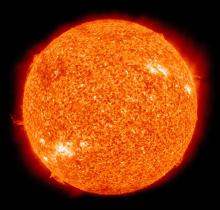Listen to today's episode of StarDate on the web the same day it airs in high-quality streaming audio without any extra ads or announcements. Choose a $8 one-month pass, or listen every day for a year for just $30.
You are here
Monuments
On the first day of the 19th century, Giuseppi Piazzi discovered a new body orbiting the Sun. He named it Ceres, after a goddess of grain. He thought it might be a planet. Instead, it was the first member of the asteroid belt — a band of debris between Mars and Jupiter.
Piazzi’s discovery opened a new realm in the solar system. It was an important finding. And it made him famous not only in the field of astronomy, but to the rest of the world as well. In fact, the people of his home town, in Italy, dedicated a statue of him 150 years ago today — 70 years after his discovery.
Statues and sculptures of astronomers are rare, but there are a few.
Nicolaus Copernicus, who demonstrated that Earth is not the center of the universe, is displayed in Warsaw and Chicago, among other locations. Galileo Galilei, who provided some of the proof of Copernicus’ idea, can be found in Florence, Oxford, and elsewhere. And both of them are on a monument at the Griffith Observatory in Los Angeles, along with four other giants of astronomy — one of whom was sculpted by the artist who created the Oscar statuette.
The brother-and-sister team of William and Caroline Herschel, from the 18th and 19th centuries, are found in the garden of their home in England. And a statue of Benjamin Banneker, the first African-American to publish astronomical works, resides in Washington, D.C. — a rare acknowledgment for an astronomer.
Script by Damond Benningfield






